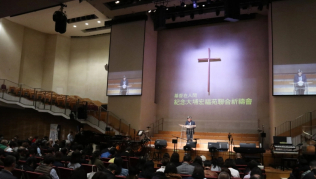Karnataka, India., Nov. 29 - In the darkness of a night, 200 villagers sat and stared at the makeshift movie screen alongside a river in Nanjanagudu, a rural community in India's southwestern Karnataka state. Six Indian men in their late 20s stood by the LCD projector they had brought to show a film about Jesus.
Ignoring the plentiful mosquitoes and mat bugs, Lakshmamma, 45, a dark-skinned Dalit woman in the crowd, winced as she watched Roman soldiers drive long nails into the body of Jesus. For the fourth time, Lakshmamma was watching Dayasagar (Ocean of Mercy), a gripping Indian-produced feature film about Jesus translated into a major Indian languages under the sponsorship of Dayspring International in Virginia Beach. As the film depicted Christ on the cross, Lakshmamma wept openly.
For the last quarter-century, Operation Mobilization (OM), Campus Crusade, Vimukthi Baptist Church, Dayspring, Gospel for Asia, and others have been penetrating the thicket of traditional Indian culture with compelling feature films about the life of Christ.
Dayasagar and the Jesus film, one or both available in 70 of India's 407 living languages, have won over large numbers of villagers. Dayspring says 19 million Indians have seen Dayasagar since 1979, and 7 million have made public Christian commitments. Campus Crusade says 500 film teams show the Jesus film to 100,000 Indians daily.
As a result, feature-film outreach has earned its place as a powerful tool for Christians in Hindu-majority India; it has also garnered severe opposition.
After the film ended in Nanjanagudu, the mostly illiterate audience listened to Prakash, one of the six missionaries who had shown it. "Brothers and sisters, you saw how the Son of God gave his life to pay for our sins," he said. Thirty minutes later, the gathering was dismissed and about 20 Dalits came forward to hear more about Jesus.
Dalits, trampled at the bottom of Hindu society, number about 300 million. Mostly landless agricultural laborers, they live in chronic poverty and experience widespread discrimination at the hands of elite, upper-caste Hindus. In recent years, Dalits have increasingly turned to Christianity and Buddhism to escape the Hindu system.
"In the Indian context of multifaith communities, propagating the story of Jesus is the wisest way to bring the people over to church," said Joseph D'Souza, president of All India Christian Council. "The chief task is to inspire an attitudinal shift and then bring them to the central idea of faith. Film evangelists in India are doing the initial part of paving the ground for a personal experience of faith."
Operation Mobilization has 140 field teams working with local churches to distribute literature and screen films. They introduce key Christian concepts, including the universal human need for salvation.
"After each show, 5 to 10 percent of viewers decide to choose Jesus as their Savior," said Kumar Swamy, director of OM's south zone. "We don't force them to change their names that identify them as non-Christians or shun their gods. In the course of time, they themselves do it." Swamy hopes to plant 1,000 new churches in southern India.
Each team conducts four screenings per week, traveling with a 40-pound power generator and related equipment. Teams have visited 85,000 villages, but 650,000 more villages remain on their list.
Campus Crusade for Christ has helped pay for film teams in India since 1983. These teams consist of three Indian Christians who show Jesus 100 times each year in remote villages. Their goal is to show the film to every one of India's 1.1 billion people.
"Our film evangelism among extremely backward tribal groups in India is proving stunningly effective," said a source at Campus Crusade in Bangalore, who asked not to be named.
He cited the case of the Bhils, a 90,000-strong tribal community living in villages of Gujarat and Rajasthan states. Bhils, an illiterate community, are stereotyped as crime-ridden, substance-abusing animists. In 1996, Campus Crusade India dubbed the Jesus film into the Bhil language and took it to their villages. Soon, 21 churches and 185 small fellowship groups sprouted.
"Now we have with us testimonials from opinion leaders of Bhils who say alcoholism and crime fell dramatically after the screening of the Jesus film to them," he said.
Many film evangelists do not just roll up the screen and leave after the show but stay for follow-up. "So far OM has launched around 390 fellowships to instill faith among new followers, and many will gradually turn into full-fledged churches," Swamy said.
All this success comes with a price in Hindu-majority India. Many Christian film evangelists across the country are facing abuse and death threats. In June 2000, Ashish Prabash, a full-time film missionary with Campus Crusade, was found stabbed to death in his home in Punjab. The killers are still at large.
Gospel for Asia reports that Titus, a missionary, was brutally beaten up earlier this year for attempting to show Ocean of Mercy in Jharkhand, a predominantly tribal area. Film ministries face the greatest hostility from Hindu militants in Bihar and Rajasthan states. "[The] threat is real and standing. We risk our lives while going into these villages with projectors and videocassettes," said one ministry leader.
Film evangelists reported at least 16 cases of assault this year. One attack took place in July in Sirsi village in Karnataka. Unnamed assailants beat up a local pastor who worked with a film team. They confiscated tracts used in the outreach and burned them.
"The day is gone when one could easily show Jesus films or distribute tracts," said Oliver D'Souza, south zone convener of the All India Christian Council. "These films leave a lasting impression on non-Christian viewers. It works like magic, and the Hindu extremists are left red-faced."
Vishwa Hindu Parishad and Rashtriya Swayamsevak Sangh, whose militant followers attack Christian film evangelists, share a political agenda with the Bharatiya Janata Party, India's ruling political party. In recent months, Hindu elites have moved to curtail the right to conversion.
In the midst of opposition, Christians in India are grappling with how to use this tool most effectively. OM workers, when not starting new churches, funnel new believers to existing local churches. Dayspring says workers have started 2,000 churches since 1979. Such claims are hard to verify, as long-term, independent studies do not exist.
Everyone involved agrees that local churches are key. Joseph D'Souza points out that long-term discipleship of new believers depends more on local congregations than on the efforts of film evangelists alone. "The church has to further utilize the effect of Jesus' story on the masses. Some churches in India still have a shallow view on this. They have to chalk out well-thought-out strategies for spreading discipleship."
Tom Steffen, a professor of intercultural studies at Biola University in southern California, agrees. "Films are most effective when connected to an ongoing church-planting movement," Steffen said. He also said most audiences should have some understanding of the Bible and the film medium. Otherwise, conversions of enthusiastic people who come forward may not last.
The experience of Lakshmamma seems to bode well for the evangelistic use of film in rural cultures, however. Standing at a windy riverside in sleepy Mysore village, Lakshmamma said, "This film on Jesus brought a new meaning to my life. As I submitted myself to Jesus, a new sense of peace dawned on me. I was born a Dalit, but I don't feel like a lesser being any more."







